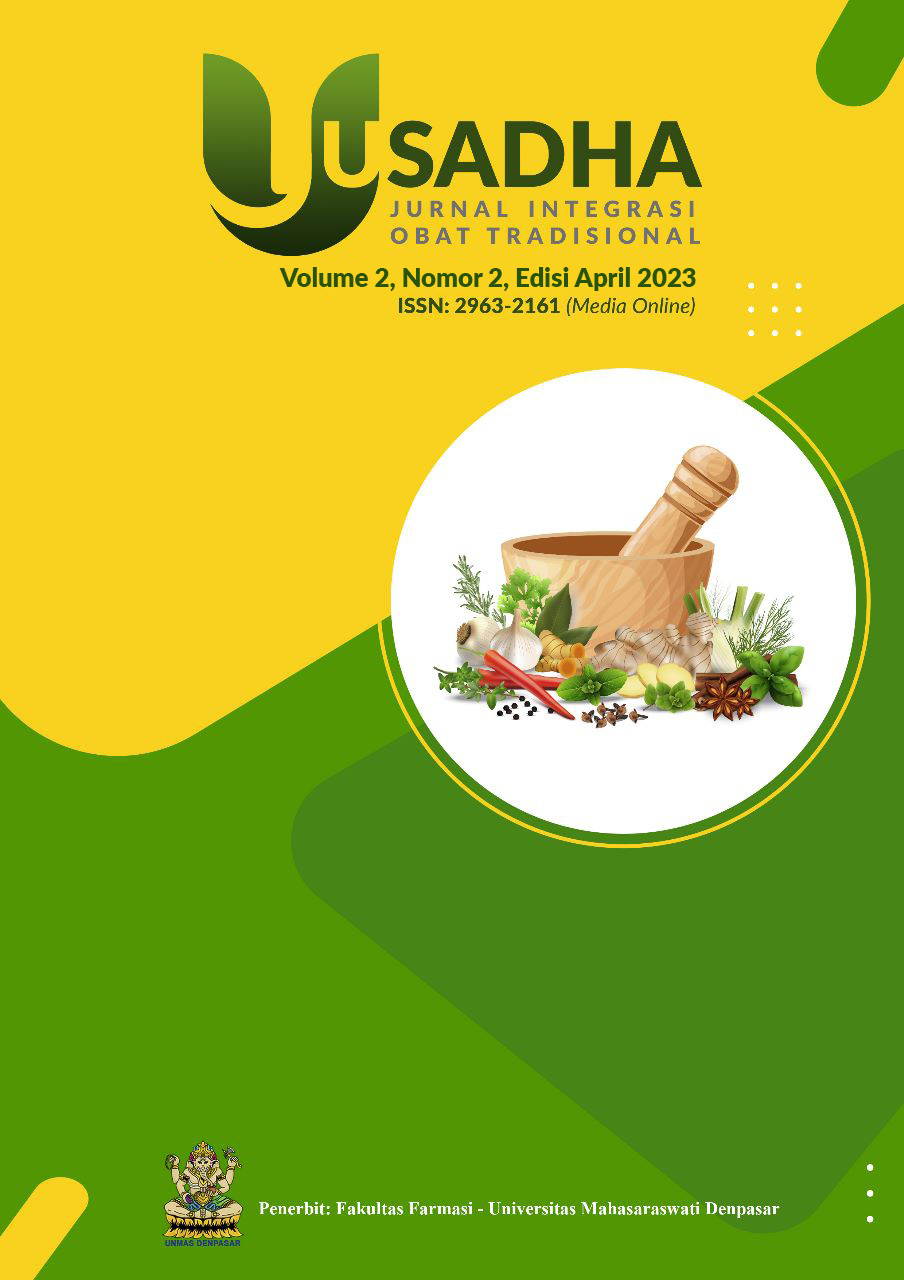Bioinformatics Study of Curzerene in Dewandaru Leaves (Eugenia uniflora Linn.) As Prostate Anticancer In PI3K Signaling
Bioinformatics Study of Curzerene in Dewandaru Leaves (Eugenia uniflora Linn.) As Prostate Anticancer In PI3K Signaling
DOI:
https://doi.org/10.36733/usadha.v2i1.6733Keywords:
curzerene, Dewandaru leaves, in silico, prostate cancerAbstract
One of the original Indonesian plants that has medicinal properties is Dewandaru (Eugenia uniflora Linn.). Dewandaru shows cytotoxic activity against cancer cells so it has the potential to be used as a drug preparation. The potential compound from the leaves of Dewandaru is Curzerene. This research was conducted to identify the interaction between the compounds of dewadaru leaves and PI3K receptors in prostate cancer. This study uses a computational method known as molecular docking. Bond energies, visualization of bonds, and types of bonds between compounds and receptors were observed. The PI3K receptor has fulfilled the method validation test requirements. The results showed that compounds from the dewadaru plant could inhibit one target protein from prostate cancer which was expressed with the lowest ∆Gbinding value, namely Curzerene compound (-7.65 kcal/mol) in PI3K protein. The interaction between Curzerene compounds has a lower binding energy value when compared to the original ligands at the PI3K receptor. Thus, it can be concluded that the Curzerene compound in the dewadaru plant used in the study has a good interaction with the PI3K receptor in prostate cancer. This compound has the potential to be developed as an anticancer drug. It is necessary to carry out in vivo testing and modification of the structure of the compound so that it can be used as an effective anticancer therapy in prostate cancer.
Keywords: Prostate cancer, Curzerene, Dewandaru leaves, In silico
References
Chodidjah. Aspek imunologik pada kanker prostat. Anat Histol Fak Kedokt Univ Islam Sultan Agung. 2009;94(118):1–14.
Kemenkes RI Nomor HK.01.07/Menkes/291/2018 Tentang Pedoman Nasional Pelayanan Kedokteran Tata Laksana Kanker Prostat. Menteri Kesehata Republik Indonesia. 2018;
Pratama FE. Review: Senyawa Aktif Antikanker Dari Bahan Alam Dan Aktivitasnya. Fak Farm Univ Padjadjaran. 2018;16:149–58.
Fidelis EM, Savall ASP, de Oliveira Pereira F, Quines CB, Ávila DS, Pinton S. Pitanga (Eugenia uniflora L.) as a source of bioactive compounds for health benefits: A review. Arab J Chem. 2022;15(4).
Santoso P et all. Skrining Fitokimia dan Uji Aktivitas Antiinflamasi Ekstrak N-Butanol Buah Dewandaru (Eugenia uniflora L.) pada Tikus Putih Jantan Galur Wistar (Rattus norvegicus) dengan Metode Paw Edema yang Diinduksi Karagenen. Medicamento. 2018;4(2):100–6.
Bahi RRR, Herowati R, Harmastuti N. Studi Biokemoinformatika Kandungan Kimia Daun Sambiloto (Andrographis paniculata (Burm.f.) Nees) sebagai Antihiperglikemia serta Prediksi Parameter Farmakokinetik dan Toksisitas. Pharm J Farm Indones (Pharmaceutical J Indones. 2020;17(2):466.
Sargsyan K. How molecular size impacts RMSD applications in molecular dynamics simulations. J Chem Theory Comput. 2017;13, n:1518–1524,.
J. Kalita D. Molecular docking, drug-likeness studies and ADMET prediction of quinoline imines for antimalarial activity. J Med Chem Drug Des. 2019;2, no:1–7.
Shorning BY, Dass MS, Smalley MJ, Pearson HB. The PI3K-AKT-mTOR Pathway and Prostate Cancer : At the Crossroads of AR , MAPK , and WNT Signaling. 2020;1.
Setiawan FF. Uji In Silico Senyawa 2,6-dihidroksiantraquinon Sebagai Ligan Pada Reseptor Estrogen Alfa. J Farm Sains dan Komunitas [Internet]. 2015;12(2):77–80. Available from: https://media.neliti.com/media/publications/229873-uji-in-silico-senyawa-26-dihidroksiantra-246cb9f8.pdf
Makatita FA. Riset in silico dalam pengembangan sains di bidang pendidikan, studi kasus: analisis potensi cendana sebagai agen anti-aging. J ABDI. 2020;2(1):59–67.
Frimayanti N, Lukman A, Nathania L, Program S, Farmasi F, Farmasi S, et al. Studi molecular docking senyawa 1,5-benzothiazepine sebagai inhibitor dengue DEN-2 NS2B/NS3 serine protease. Chempublish J [Internet]. 2021;6(1):54–62. Available from: https://doi.org/10.22437/chp.v6i1.12980
Aziz FK, Nukitasari C, Oktavianingrum FA, Aryati LW, Santoso B. Hasil In Silico Senyawa Z12501572, Z00321025, SCB5631028 dan SCB13970547 dibandingkan Turunan Zerumbon terhadap Human Liver Glycogen Phosphorylase (1l5Q) sebagai Antidiabetes. J Kim Val. 2016;2(2):120–4.
Toren P, Zoubeidi A. Targeting the PI3K/Akt pathway in prostate cancer: Challenges and opportunities (Review). Int J Oncol. 2014;45(5):1793–801.
Akinleye A, Avvaru P, Furqan M, Song Y, Liu D. As Cancer Therapeutics. 2013;1–17.
Karim JA. Molecular dan Genomic Biomarker sebagai Deteksi Dini pada Diagnosis Kanker Prostat. J Ilm Kedokt Wijaya Kusuma. 2020;9(2):156.
Nunes TA de L, Santos MM, de Oliveira MS, de Sousa JMS, Rodrigues RRL, Sousa PS de A, et al. Curzerene antileishmania activity: Effects on Leishmania amazonensis and possible action mechanisms. Int Immunopharmacol. 2021;100(August):1–10.
Lee HW, Wang HT, Weng M wen, Hu Y, Chen WS, Chou D, et al. Acrolein- and 4-Aminobiphenyl-DNA adducts in human bladder mucosa and tumor tissue and their mutagenicity in human urothelial cells. Oncotarget. 2014;5(11):3526–40.

Downloads
Published
Issue
Section
License
Copyright (c) 2023 Usadha

This work is licensed under a Creative Commons Attribution-NonCommercial 4.0 International License.




